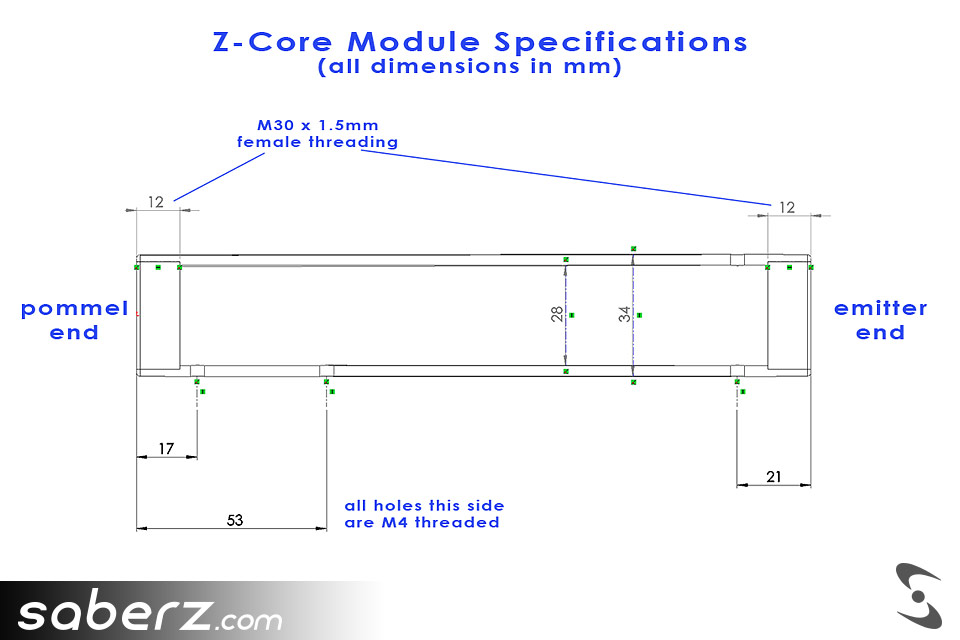Z-Core System (ZCS)
Intro
Illuminated sabers based on high-powered LEDs are undeniably awesome. Every sci-fi fan who gets the chance to see one firsthand can easily see how much fun they are. But until now, working hilt electronics - especially sound cards - have required hilts with outer diameters no smaller than about 1.5". These sabers look great, but they don't feel as good in the hand. During the production of Star Wars, smaller-diameter saber hilts were used specifically because of their superior ergonomics. The motivation behind the creation of ZCS was to enable the construction of hilt components that allow for modular saber construction at these smaller diameters, but still accommodate premium hilt electronics.
Put simply, ZCS makes better sabers.
We publish all the ZCS standards so that other sabersmiths can create their own individual parts or complete sabers. We sell our own sabers and components, but we want everyone to be able to enjoy superior hilt ergonomics. Therefore, ZCS is freely available to anyone who wants it, subject to a Creative Commons License. The specifics of the license are available at the preceding link, but the most important requirement is that if you are going to use ZCS to make and sell your own sabers, you must provide a link back to Saberz.com. A link directly to Saberz.com is required, but you can add a second link to this page if you like.
Saberz.com Hilts
Before we get into the standards themselves, it is important to note how hilts from Saberz.com are constructed. Other sabersmiths might take ZCS in a slightly different direction, as there is lots of room for creativity in the standard. So we want to establish how we do things here at Saberz.com.
Every hilt we make is based on a central component, which we call the Z-Core Module. The Module houses all the hilt electronics including the LED, heatsink, switches, recharge port, battery, speaker, and soundboard. All of our Z-Core Modules feature a removable switch plate that allows for easier installations, and a very smooth integration with 12mm illuminated AV switches and a 2.1mm recharge port.
The Z-Core Module is threaded on both ends, and has multiple threaded holes along its length. This allows for the easy attachment of ZCS components (emitters, pommels, shrouds, etc) as well as standard accessories like Covertec clips and D-rings. The result is simple: a Z-Core Module becomes a complete saber by attaching ZCS parts, and can easily become a completely different saber by swapping them out. With that in mind, here is how ZCS components are built.
Definitions
The most important dimensions for any Z-Core saber are the thread size/pitch of M30 x 1.5mm, used to attach differerent pieces together, such as putting pommels and emitters onto our Z-Core Modules. All of the shrouds and accessories are bolted on to the Modules via M4 threading on holes spaced at particular points on the Modules. These dimensions are described in the image below:

Also important, but not completely described by the image above, is how a Z-Core Emitter interfaces with the Module. ZCS assumes a few things about the LED. First, that it's a star-type high-powered LED. Second, that it's mounted on the ZCS heatsink. And finally, that there is an optic directly on top of the LED that adds another 10-12mm of height or so. The heatsink is held in place by a set screw that threads into the Module (the hole that's 21mm from the right on the graphic above), and pushes against the side of the heatsink. There is a little wiggle room to position that heatsink in the perfect place, such that when the Emitter threads into the Module, it keeps the LED and optic in place without needing any adhesive. Of course, it may be nice to have just a little adhesive keeping the optic in place, so it doesn't fall out while swapping out Emitter pieces. We like to use a small dab of superglue for that job, making sure that it doesn't cover any of the LED dies themselves, just the empty space around them. Once the Emitter is on and the saber is assembled, ZCS geometry keeps everything locked perfectly in place.

Compatibility
As mentioned above, different sabersmiths might do slightly different things with ZCS, and we want to provide some guidance on how they can describe their creations. Firstly, the bare-minimum of ZCS-compatibility would be to use our thread standard of M30 x 1.5mm. If that is the extent of your compatibility, you'd say that the saber has ZCS threading. If you go further to make sure that all our emitters, pommels, and other accessories can be attached to your saber without issue, you could say the saber is fully ZCS-compatible. That will indicate to the buyer that they can come to Saberz.com and use any of our components on your saber. If you fall somewhere in-between, it's advised that you describe precisely what it is that your saber is and isn't compatible with.
As stated above, The Z-Core System (ZCS) is licensed under a Creative Commons License.